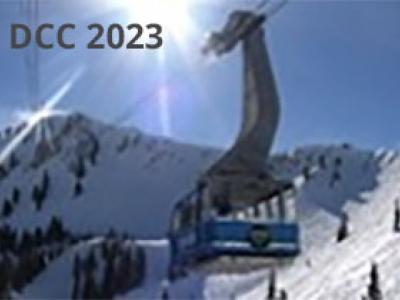
DCC 2023 Conference - The Data Compression Conference (DCC) is an international forum for current work on data compression and related applications. Both theoretical and experimental work are of interest. Visit the DCC 2023 website.

- Read more about Decoder-side Affine Model Refinement for Video Coding beyond VVC
- Log in to post comments
Decoder-side motion vector refinement (DMVR) was adopted into versatile video coding (VVC) and later was further improved in the enhance compression model (ECM) to improve the inter prediction accuracy by refining the motion vectors (MVs) derived from previously coded blocks in merge mode based on bilateral matching. However, DMVR can only be applied to blocks coded with translational motion. Affine motion compensation as supported by VVC can capture more complex motion and thus increases inter prediction accuracy, but DMVR is not applied to blocks coded with affine motion in VVC.
- Categories:
 58 Views
58 Views
- Read more about Lossless Point Cloud Attribute Compression Using Cross-scale, Cross-group, and Cross-color Prediction
- Log in to post comments
This work extends the multiscale structure originally developed for point cloud geometry compression to point cloud attribute compression. To losslessly encode the attribute while maintaining a low bitrate, accurate probability prediction is critical. With this aim, we extensively exploit cross-scale, cross-group, and cross-color correlations of point cloud attribute to ensure accurate probability estimation and thus high coding efficiency.
- Categories:
 69 Views
69 Views
- Read more about Learned Disentangled Latent Representations for Scalable Image Coding for Humans and Machines
- Log in to post comments
As an increasing amount of image and video content will be analyzed by machines, there is demand for a new codec paradigm that is capable of compressing visual input primarily for the purpose of computer vision inference, while secondarily supporting input reconstruction. In this work, we propose a learned compression architecture that can be used to build such a codec. We introduce a novel variational formulation that explicitly takes feature data relevant to the desired inference task as input at the encoder side.
- Categories:
 30 Views
30 Views
Decoder-side intra mode derivation (DIMD) is a promising coding tool in the enhanced compression model (ECM) developed by the joint video experts team (JVET). In DIMD, the intra prediction mode of a luma block is derived based on the gradient information of the adjacent luma samples at both encoder and decoder, rather than being explicitly signaled in the bitstream. Inspired by DIMD, a decoder-side chroma intra mode derivation (DCIMD) method is proposed in this paper to improve the coding efficiency of chroma intra prediction.
DCC_DCIMD.pdf
- Categories:
 71 Views
71 Views- Read more about Practical construction of sensing matrices for a greedy sparse recovery algorithm over finite fields
- Log in to post comments
Compressed sensing aims to retrieve sparse signals from very few samples. It relies on dedicated reconstruction algorithms and well-chosen measurement matrices. In combination with network coding, which operates traditionally over finite fields, it leverages the benefits of both techniques. However, compressed sensing has been primarily investigated over the real field. F2OMP is one of the few recovery algorithms to reconstruct signals over finite fields. However, its use in practical cases is limited since its performance depends mainly on binary matrices for signal recovery.
- Categories:
 33 Views
33 Views
- Read more about A Low Complexity Convolutional Neural Network with Fused CP Decomposition for In-Loop Filtering in Video Coding
- Log in to post comments
- Categories:
 64 Views
64 Views
- Read more about Gradient Linear Model for Chroma Intra Prediction
- Log in to post comments
In Versatile Video Coding (VVC), Cross-component Linear Model (CCLM) predicts chroma samples by assuming a linear relationship between luma and chroma components. In performing CCLM for video in YUV 4:2:0 chroma format, collocated luma samples are firstly downsampled by a low-pass filter to match luma resolution with chroma, and one linear model of luma-chroma sample pairs is applied on the reconstructed luma samples to generate the predicted chroma samples.
- Categories:
 87 Views
87 Views
- Read more about On the future of decoder-side depth estimation in MPEG immersive video coding
- Log in to post comments
This paper presents the new profile to supersede the existing Geometry Absent profile supported in the MPEG immersive video (MIV) coding standard. The proposed MIV Extended Decoder-Side Depth Estimation (MIV DSDE) profile was developed to cover more diverse use cases and applications based on the decoder-side depth estimation scheme and allow for further improvements of the efficiency of incoming MIV ed. 2, even after the standard will reach its final stage.
DCC_DSDE.pdf
Full_text.pdf
- Categories:
 62 Views
62 Views
Recently, cross modal compression (CMC) is proposed to compress highly redundant visual data into a compact, common, human-comprehensible domain (such as text) to preserve semantic fidelity for semantic-related applications. However, CMC only achieves a certain level of semantic fidelity at a constant rate, and the model aims to optimize the probability of the ground truth text but not directly semantic fidelity. To tackle the problems, we propose a novel scheme named rate-distortion optimized CMC (RDO-CMC).
2023003317.pdf
- Categories:
 66 Views
66 Views
- Read more about Model Compression for Data Compression: Neural Network Based Lossless Compressor Made Practical
- Log in to post comments
- Categories:
 71 Views
71 Views